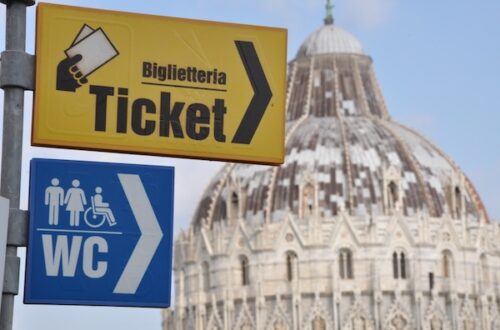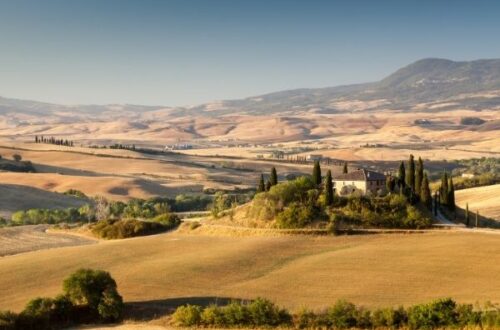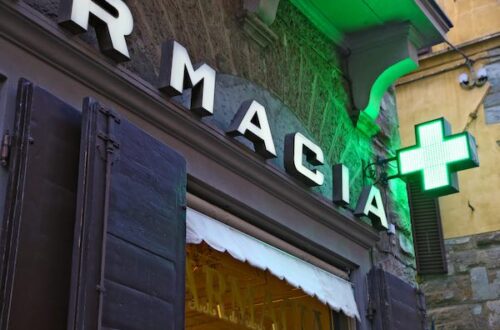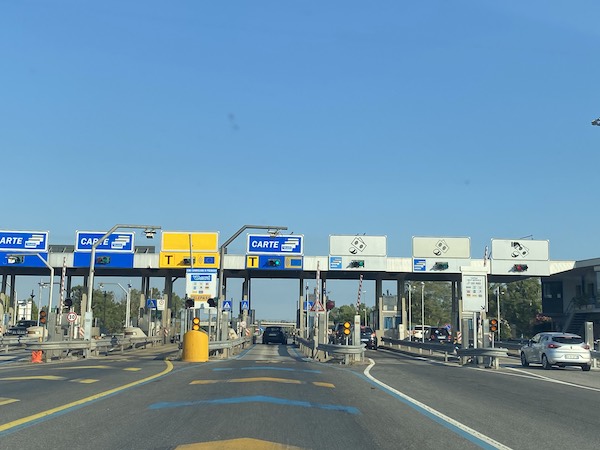
Autostrade: Italian toll roads: all you need to know about Italy’s motorways
All you need to know about Italian toll roads (autostrada): how they work, what to expect, a list of Italian motorways/ highways, tips
If you are planning on driving in Italy, it is handy to know that the best and fastest roads in Italy are toll roads or, as we call them in Italian: autostrade.
Autostrade criss-cross the country from north to south and east to west.
They are well kept, easy to use and fast.
They are, however, also pricey and, if you are not used to them, they may leave you unsure about how to use them.
If traveling long distances, Italian toll roads are excellent.
Today, I share all you need to know about motorways in Italy: I will cover what they are, how to know what to pay, how to pay and what to expect during your journey.
If you are traveling on a budget, at the end of this article, you will also find a section detailing how to avoid Italian toll roads.
Italian toll roads: what they are
Italian highways / motorways / freeways are called autostrada (singular) / autostrade (plural).
They usually have two lanes each way and they are managed by companies such as Anas, Societa’ Autostrade and others which charge for their use and maintenance.
Italian toll roads are marked by green signs with white lettering, which makes them easy to spot and recognize.
They have an entrance booth and exit booth: you collect an entry ticket as you get onto it and pay when leaving.
All info about paying for Italian highways is below!
List of Italian autostrade/ toll roads
Italy toll roads are called autostrade.
They are indicated by street signs with a green background and white writing and are marked by names that include the letter A (for Autostrade and a number); occasionally, they also have a name or nickname, such as ‘autostrada del sole’ (A1) or Autostrada del Brennero (A22)
This is the current list of the main Italian toll roads:
| Autostrada N. | Start /end | Name / Also known as |
| A1 | Milan – Naples | Autostrada del Sole |
| A2 | Salerno – Reggio Calabria | Autostrada del Mediterraneo |
| A3 | Napoli/Naples – Salerno | |
| A4 | Torino/Turin -Trieste | Serenissima |
| A5 | Torino/Turin-Aosta | Autostrada del Monte Bianco |
| A6 | Torino/Turin – Savona | Autostrada Verdemare |
| A7 | Milano/Milan – Genova/Genoa | Autostrada dei Giovi |
| A8 | Milano/Milan-Varese | Autostrada dei Laghi |
| A9 | Lainate-Como | Autostrada dei Laghi |
| A10 | Genova/Genoa- Ventimiglia | Autostrada dei Fiori |
| A11 | Firenze/Florence-Pisa | Autostrada Firenze Mare |
| A12 | Genova/Genoa-Rosignano-Civitavecchia-Roma/Rome | Autostrada Azzurra |
| A13 | Bologna- Padova | |
| A14 | Bologna -Taranto | |
| A15 | Parma – La Spezia | Autocamionale della Cisa |
| A16 | Napoli/Naples -Canosa | |
| A18 | Messina – Catania | |
| A19 | Palermo- Catania | |
| A20 | Messina – Palermo | |
| A21 | Torino/Turin-Brescia | |
| A22 | Brennero – Modena | Autostrada del Brennero |
| A23 | Palmanova-Tarvisio | |
| A24 | Roma/Rome- L’Aquila-Teramo | Autostrada dei Parchi |
| A25 | Torano – Pescara | Autostrada dei Parchi |
| A26 | Genova/Genoa- Gravellona | |
| A27 | Belluno-Venezia/Venice | |
| A28 | Portugruaro – Conegliana | |
| A29 | Palermo – Mazara | |
| A30 | Caserta – Salerno | |
| A31 | Vicenza -Thiene | Autostrada della Val d’Astico |
| A32 | Torino/Turin – Bardonecchia | Autostrada del Frejus |
| A33 | Asti – Cuneo | |
| A34 | Villesse – Gorizia | |
| A35 | Brescia – Milano | Autostrada BreBeMi |
| A36 | Cassano Magnago – Lentate sul Seveso |
As well as these main Italian toll roads, there are more Italian highways operating as connections between big ones, or ring roads around bigger cities.
These additional roads usually have names such as raccordo or bretella.
Who can use Italian autostrade
Italian autostrade are fast roads and are therefore only open to vehicles able to meet minimum speed standards.
This means can drive on Italian motorways if you travel:
- By car, campervan or car + trailer (such as a roulotte)
- By motorcycle over 150cc
- Trucks
You need a full driving license to drive on Italian toll roads and, possibly, an international driving permit. Make sure you check all requirements before getting on the road as checks do happen.
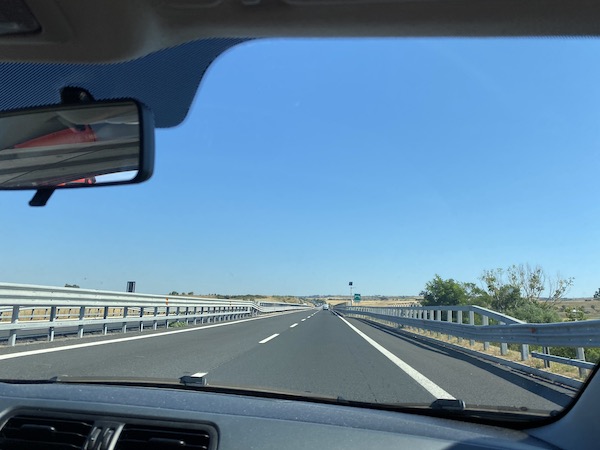
How Italian toll roads work
In the vast majority of cases, Italian toll roads charge you by distance traveled: to calculate this, they have toll booths when you enter the motorway and exit.
It works like this.
Entering italian autostrada
As you approach the booth, you will need to get in lane: you will have to choose either a Telepass lane or a ‘biglietto’ lane.
Most likely, you want the ‘biglietto’ lane.
Telepass is for pass holders – unless your car rental company told you specifically that they have the toll box in the car, you are not one of them!
Check here >> our tips for renting a car in Italy.
Biglietto lanes – biglietto in Italian means ticket and this is the lane you want.
You get in lane, stay in your car, line up. The machine will be on your left (driver’s side).
You will see a ticket sticking out: take it, and put it safely away: you will need it when exiting.
If you do not see a ticket sticking out, you can press the big red button beside the words ‘biglietto’: it should come out in no time.
Need to know: the ticket is the proof you entered the motorway in a certain location. Should you lose it, they will charge you from the very start of the highway as if you have used it all. This could add up to several hundred kilometers, so make sure you do not lose your ticket, or the price will hurt!
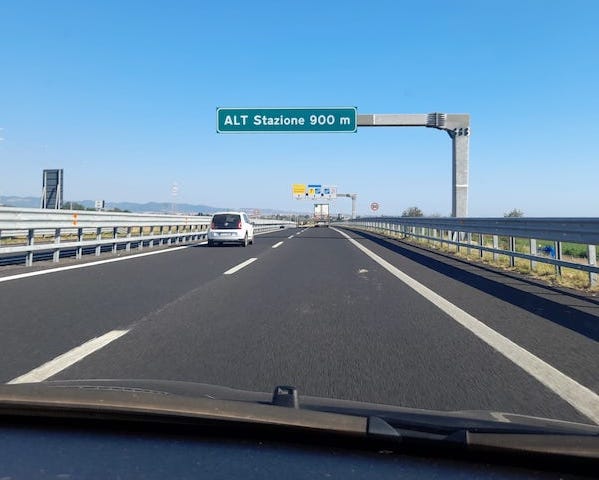
Exiting the motorway
Motorway/ highway / Autostrade exits are called ‘uscite’.
When you see your announced, move onto the right lane and prepare to turn.
In Italy, lanes work slightly differently than in US and getting in lane is usually not enough. You often have to take an actual ‘slight’ right’ to exit the motorway.
As you exit the highway, you will find a second toll booth where you will pay your toll.

How to pay Italian highway tolls (pedaggio)
In Italy, you pay your autostrada toll when exiting the highway, either by cash, card or Telepass.
When you arrive at your exit, you will find another toll booth.
Usually, you will be prompted to get in lane and the options given are the following.
Telepass – this is the lane for cars equipped with a telepass toll box. Unless you know for sure you have one, this is not the lane for you.
If you do have Telepass, just slow down, allow time for the machine to read your box and keep going.
Carte (cards) – use this lane if you want to pay your toll by credit or debit card.
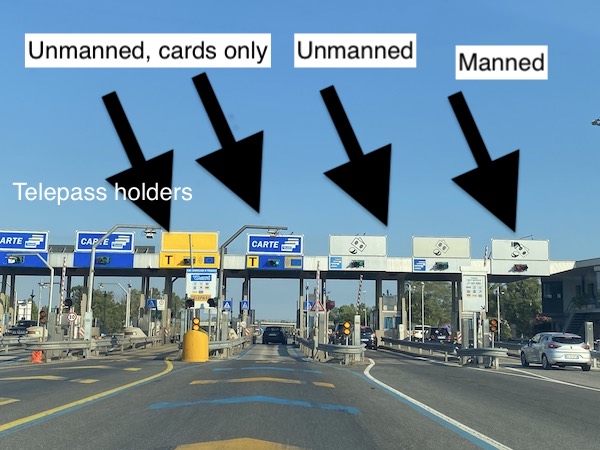
To use this lane, you need to drive up to the booth; the machine will be on your left (drivers’ side).
You need to:
Insert your ticket into the machine – usually, a large green arrow flashes indicating where to put it
check the amount due on the display
Inserts your cards in the dedicated slot – another large green arrow usually shows the correct place
to retrieve your card. Wait for the ‘grazie‘ (thank you) message and you are free to go.
Tip! Only use this lane if you know for sure your card works in Italy! Getting to the booth and having to reverse as your card gets rejected may be proof dangerous or impossible if there is a queue, so it is something to avoid at all costs!
Cash (unmanned) – this is usually indicated by a white street sign with a drawing of coins and notes.
If you get into one of these lanes, you will deal with a machine.
You need to:
- Insert your ticket into the machine – usually, a large green arrow points at the correct slot
- Check the amount due on the machine display
- Pay with either cash or notes
- Retrieve your change (if any)
- Wait for the thank you message / bar to go up
- Go
Top tip! I recommend you drive as close to the machine as possible. Unless you have long arms, inserting your ticket and retrieving change can prove tricky if you are too far away and stepping out of the vehicle is not allowed. Been there, done that, so please follow my advice and get as close to your left as you can!
Cash (manned) – this is usually marked by a white sign with a black drawing of a hand, coins and notes.
If you get onto this lane, you will have a real-life person to give you change.
If you get to a line with a person operating the toll booth, things are even more straightforward: you will have to handle your ticket to them, wait for the display to show the amount due and pay.
Getting gas on Italian toll roads
Italian toll roads have regular gas stations.
They are called area di servizio and area, usually equipped with gas pumps, and a café/ restaurant, and restrooms.
Bigger ones may have more extensive meal options, an actual restaurant, a convenience store and even a small kids’ playground.
However, this is not a given and you may also only find very basic gas facilities. It is good not to have expectations that are too high!

To get gas, you will probably have the option of going self service or served (servito).
Good to know! If coming from the US, it may be handy to know that the color coding for the pumps is different in Italy than in the USA (I was caught in it the other way around!): make sure you read which is super and which is diesel.
You can usually pay to the person serving you or inside, at the till, by saying the number of the pump you used.
Where to recharge an electric car on Italian toll roads
Italy is working hard to add electric charging points so the best way to find a charging station is to rely on your own car’s charging stations map.
At present, however, these autostrade stations are marked as equipped with charging points:
A1 Milano-Napoli
- Frascati Est and Frascati Ovest, area di servizio San Cesareo – tratto Roma Sud;
- Secchia Ovest Km 156,5 southbound, 2 Ultra Fast 300 kW;
- Flamina Est Km 509,1, northbound, 2 Ultra Fast 300 kW.
A4 Brescia -Padova
- Monte Baldo Ovest, area di servizio 4 chargers 11 kW;
- Tesina Est, 1 charger 22kW;
- Limenella Ovest, 1 charger up to 50 kW.
A5 Autoporto con una colonnina che supera i 50 kW.
A7 – Dorno Est and Ovest, 2double technology 43 kW and 50 kW .
A10 Genova – Ventimiglia
- Rio Rinovo Nord, 4 Ultra Fast 350 kW;
- Ceriale Sud, 4 Ultra Fast 350 kW.
A12 – Brugnano Est e Ovest.
A15
- Tugo Ovest con colonnina fino a 22 kW;
- Montaio Ovest con colonnina da oltre 50 kW.
A22
- Passo del Brennero,16 Tesla, 1 ultra-fast 150kW, 1 charger multi-standard fast 50kW and 1 charger AC 22 kW;
- Stazione autostradale Bressanone/Val Pusteria 1 charger multi-standard fast50kW, 1 charger AC 22 kW;
- Paganella Est multi standard fast 50kW;
- Paganella Ovest 1 fast charger multi-standard 50kW, 1AC 22 kW;
- Nogaredo Ovest 1 fast charger multi-standard 50kW, 1 charger AC 22 kW;
- Rovereto sud 2 fast charger multi-standard 50kW, 1 charger AC 22 kW;
- Stazione autostradale Affi 16 Tesla, 1 fast charger multi-standard 50kW, 1 charger AC 22 kW;
- Mantova Nord 1 fast charger multi-standard 50kW, 2 chargers AC 22 kW;
- Po Ovest, 1 fast multi-standard rapida 50kW, 2 AC 22 kW.
A25
- Montevelino Nord e Sud double attachment Type 2 up to 22 kW;
- Brecciarola Nord e Sud doube plug Type 2.
Stopping for lunch on Italian toll roads
Along Italian autostrade you can get food in most gas stations.
What you get varies from station to station but you usually find at least some basic ‘bar’ offerings meaning coffee, water, sandwiches and light snack.
Sometimes, you come across real restaurants which are usually decent but, most of all, fast.
In Italy, a typical chain store/ restaurant you find on toll roads is called Autogrill.
They are usually rather well served and all have the same offering, which is handy if you are traveling with kids as they will know what to order: Autogrill’s Panino con la cotoletta has been a classic for Italian road trips for generations!
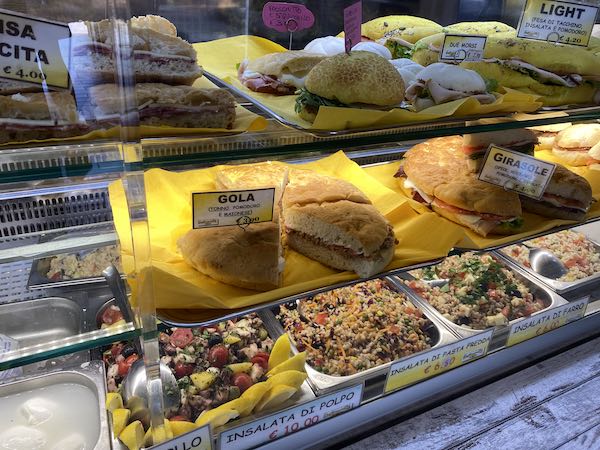
In the past, they were so common the word Autogrill became a synonym of autotrade gas station.
However, there is more of a mix now. Don’t be surprised if you have read about Autogrill but do not find on on your way.
Listening to the radio / Traffic news on Italian toll roads
While driving on an Italian motorway, you can get traffic news and updates on radio FM 103.3, Isoradio.
The music they play feels like a jump back into the 80s in Italy, but the signal is clear and the traffic updates are handy.
Road signs on Italian motorways
The road signs on autostrade are green with white writing.
Uscita signs indicate exits.
Blue, round signs with white writing indicate a minimum speed on certain lanes.
Italian toll roads can have two to three lanes. The right one is the low one, the middle one is the middle speed and the left-hand side one is for faster vehicles. Often, the lanes have minimum speed limits: 60Km/h in the slow lane; 90 km/h on the middle lane.
The sign for maximum speed limit is round, white with a red border and a number in the center.
The maximum speed limit on Italian motorways is 130 Km/h 110 km/h (good weather / bad weather) unless otherwise indicated. Different rules apply to newly licenced drivers and cars pulling trailers.
Make sure you familiarize yourself with the official Italian rules of the road before getting in the car.
Toll booth are announced by large signs saying ALT Stazione or also Pedaggio (see below)
Emergency pull-outs are marked regularly on the right side of the road, where you also find the emergency lane.
Emergency services on italian autostrade
Italian autostrade have regular SOS columns to call for help. They are yellow, on the right-hand side of the road.
The official emergency numbers in Italy are:
112 General emergency
118 Medical emergency / ambulance
Please note you may need add area codes, depending on the settings of your phone and your set up for location services.
Italian words for motorway / toll road driving
- Autostrada – highway/motorways / toll road
- Casello – Italian toll station / toll botth
- Biglietto – ticket
- Uscita – Exit
- Area di servizio – gas station
- Colonnina SOS – SOS point
- Piazzola di sosta – emergency pullout
- Autogrill – a type of gas station with food
- Pompa di benzina – gas pump
- Benzina – gas / petrol / gasoline
- Diesel – diesel
- Servito – manned / services
- Casellante – person at the toll booth
Cost of Italian motorways – Toll roads in Italy price
The cost of your autostrada trip depends on the distance traveled.
You can get an estimate by the Autostrade People themselves on this >>> autostrade toll calculator.
To give you an example:
Milan – Rome Nord (536 KM) currently costs 41.50 Euro
Naples – Salerno (82 KM) currently costs 5.60 Euro
How to avoid Italian toll roads
It is usually possible to avoid Italian toll roads entirely by following alternative routes such as Strade Statali.
Strade Statali are long, good roads and they are usually smaller than motorways, slower yet better than local ones in terms of efficiency of movement.
Strade Statali are indicated by blue signs with white writing and the code SS. The speed limit on them is usually 90 Km/h.
Even smaller roads would be marked as SP (Strade Provinciali). Anything smaller will just be a local road.
Need to know: occasionally, on larger roads, there may be a toll booth you didn’t expect. This is not overly common; however, it does happen, so it is useful to always have some euro coins on you.
This usually does not happen if you make a conscious effort to stay on strade statali or smaller ones. Anything marked by a green background road sign may lead you to incur intoo a charge.
I hope you found this quick guide to useing Italian toll roads useful. Safe travels!


